The movement has grown significantly from a group of nearly hundred protesters to thousands blocking a highway. A step towards mitigating fossil fuel subsidies; activists reflect on challenges.
Story by Indy van der Heijden, Priscila Navarrete, Alexandra Kossolapova, Diego Sánchez
Victor van der Wurff is sitting in a touring bus in police custody for blocking the A12 highway leading into The Hague. The 27-year-old is a member of the international movement Extinction Rebellion and is responsible for training local groups in the country. He has been taken into police custody, with around 600 other climate activists, to the outskirts of the Dutch political capital. Once they reach the football stadium of Ado Den Haag, the city’s football club, they are released. “After that I just took the tram back to the A12, and I got arrested again,” he says proudly. He is not the only one who did so. In fact, he knew people who were arrested three or four times a day during these protests.
In September, Dutch climate activists managed to obstruct highway traffic from going into the city for nearly a month. They wanted to stop the Government’s flow of 37.5 billion euros a year into the fossil fuel industry. The protests paid off. The motion successfully passed through parliament in October, and the demonstrators stood up from the road.
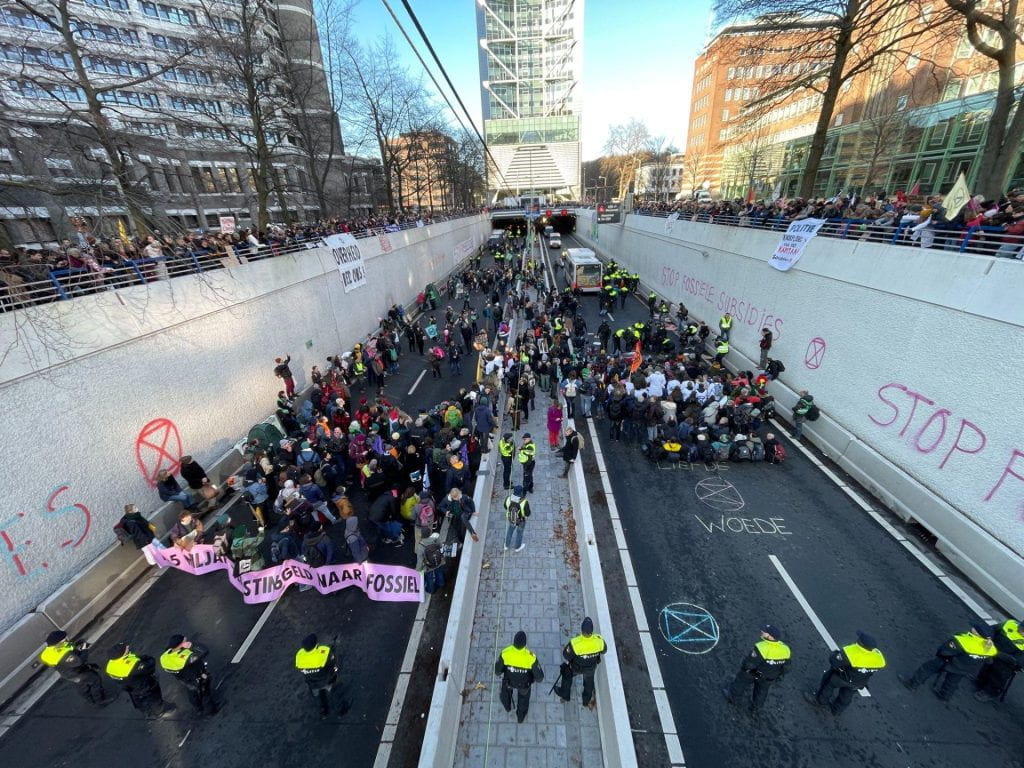
Protesters blocking highway A12 in January 2023. / Credit: Extinction Rebellion
Extinction Rebellion, also known as XR, has caught the attention by using non-violent direct action and civil disobedience to demand for green policies in many countries. “You see that the movement is growing, you see an impact starting to happen. To be part of it is simply exhilarating. I genuinely think so,” says Van der Wurff.
Feeling of urgency
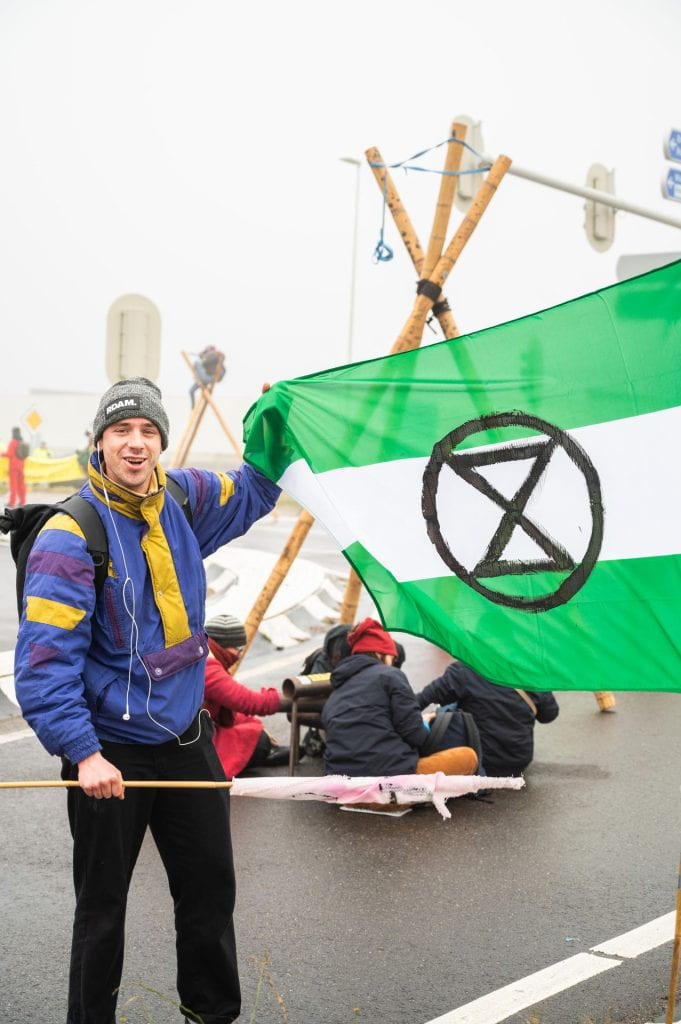
Victor van der Wurff during a protest. / Credit: Savannah van den Roovaart
Van der Wurff was about to enter his teenage years when his father showed him Al Gore’s documentary film An Inconvenient Truth. The bleak prospects painted by the United States’ ex-vice-president galvanised Victor into action. He went on to study climate science at university and worked for a fundraising company selling subscriptions for a climate NGO, but nothing suited him as well as activism. “Activism offers one of the greatest antidotes against feelings of hopelessness, you can actually do something against these things. You are dealing with the core of the problem.”
This 27-year-old activist lives in Rotterdam, the second largest city in the Netherlands. He became an activist in 2018, and in 2021 he got in touch with some members of Extinction Rebellion during a protest. His life has changed completely since that moment. He has taken on responsibilities that he never thought of before. “Now 99% of my time is devoted to XR. It’s not the climate crisis per se that is heavy, but more being so passionate about it and wanting to do so much,” he says.
Van der Wurff´s feeling of urgency is shared with many other young people. A recent survey research conducted by Ipsos for the climate NGO Milieudefensie Jong (Dutch youth section of Friends of The Earth) has revealed that 40% of respondents have a desire to take action, but do not know exactly how. Even more interestingly, 9 out of 10 of the surveyed youth experiences negative emotions when thinking about the climate and 1 out of 5 is experiencing a phenomenon called “eco-anxiety”. This means that aside from feelings of anger, anxiety and sadness, these people experience physical symptoms such as headaches and exhaustion.
The hyperactive climate advocate, who consults local XR groups, points out that there are pros and cons to getting involved. “There is not really any limit. It is not like a job in which you have certain boundaries. No one tells you what to do, so no one stops you either. I notice parts of my life get lost, there is very little time left for anything besides this,” he reflects.
The rise of Extinction Rebellion
Within just a year, the support for XR skyrocketed in the Netherlands. The organisation first struggled to gather 100 people to attend blockades, until they expected 10,000 activists to join the near month-long blockade in September. “When I joined XR, it was teeny-tiny,” van der Wurff recalls. “We were ecstatic if we could manage to get 200 people on the road, now we exceed this number by thousands.” He sounds quite optimistic about the recent growth in attendance. “I think the role of protests in the Netherlands is evolving and is taking on a different role in society.”
Jacquelien van Stekelenburg, professor in sociology and expert in social change at the Vrije Universiteit Amsterdam, highlights the rise of the organisation in the Netherlands. “Extinction Rebellion has, in an incredibly clever way, through attention-grabbing actions and tight media management, ensured that they consistently appeared in the news. As a result, they became bigger and bigger.”
Extinction Rebellion emerged in London in 2018 when a group of activists announced a “Declaration of Rebellion” against the UK government, demanding measures to halt mass extinction and minimise ecological collapse. A few days later, thousands of demonstrators blocked five major bridges and dug a hole to bury a coffin symbolising the future. After this event, the organisation spread rapidly. There are now branches in 88 countries around the world.
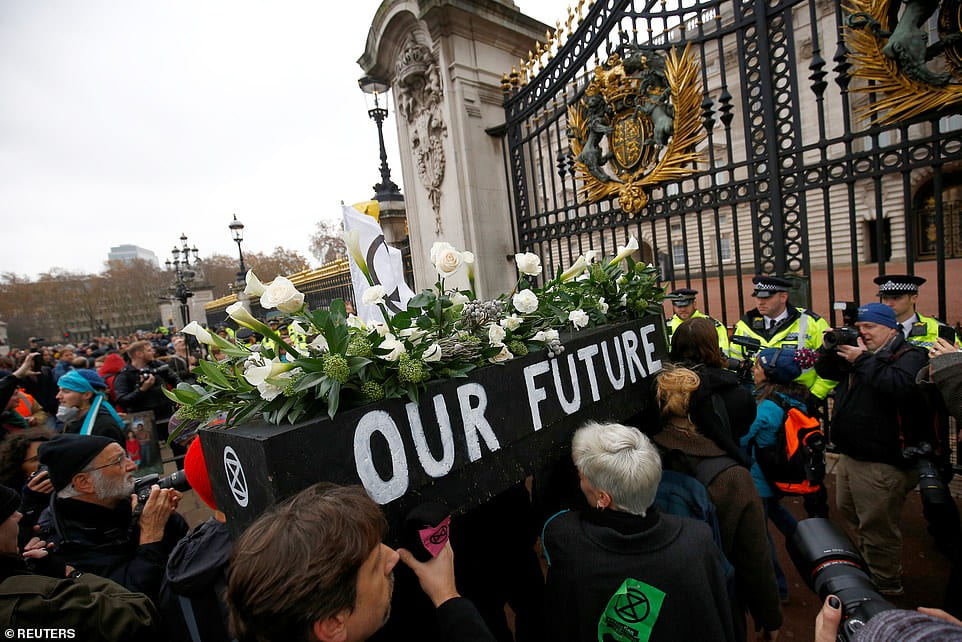
Protesters carry a coffin during a demonstration in Buckingham Palace in 2018. / Credit: Reuters
In the Netherlands, XR is a decentralised movement that is made up of 48 local groups which are supported by an overarching national organisation. “Each local group organises decentralised actions on themes they consider to be important in their municipality or local government,” van der Wurff explains.
Non-violent direct actions
On Friday December 8, van der Wurff’s local action group took it to Europe’s largest port in Rotterdam. “We blocked traffic and made areas of the port inaccessible, meaning that parts were unable to function properly, causing companies to lose money.” The action ‘Herover de Haven’ (Reclaim the Port) is a good example of a non-violent direct action, one of the strategies used by XR. These tactics are predominantly about roadblocks, sit-ins, provoking arrests, and other disruptive actions. “It is all about getting media attention and wearing down the state apparatus, like for example exhausting the police’s capacity,” states van der Wurff.
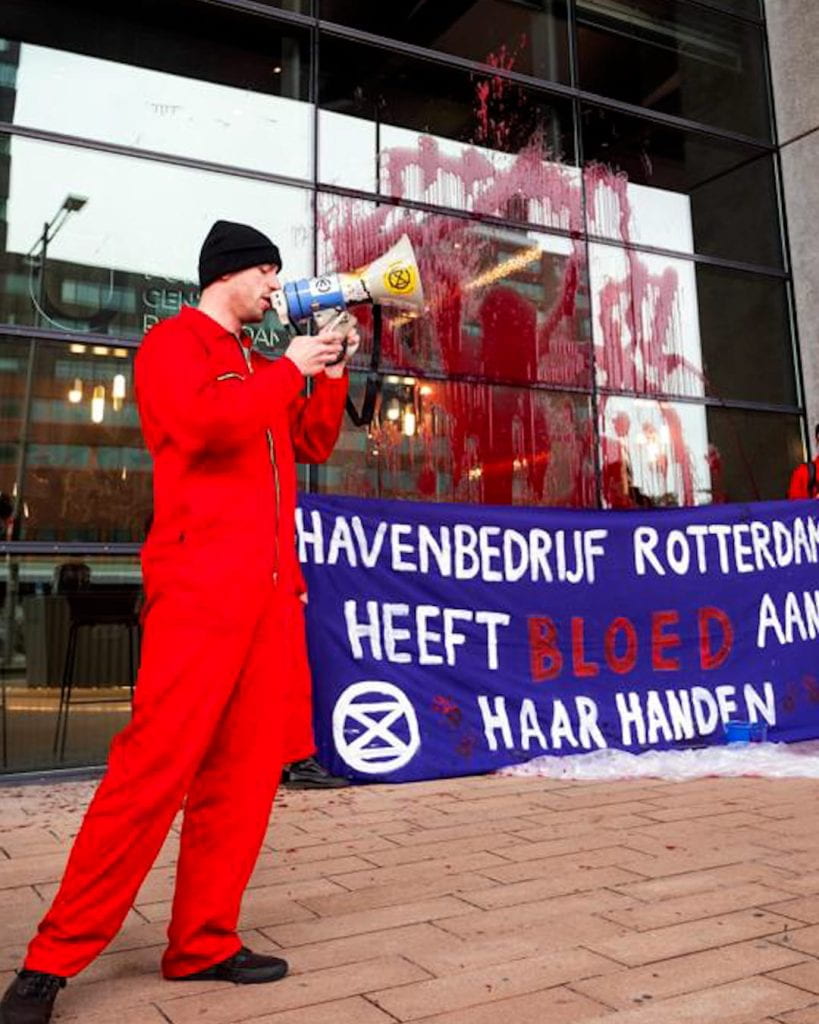
Victor during a protest at the Rotterdam harbour / Credit: Savannah van den Roovaart
XR’s non-violent direct methods are also related to the sharp influx of protest participants. The blockade of the A12 did not only see a rise in participants, but also a rise in arrests. “In the event that government actions provoke indignation, that might be the final push for people to get involved,” explains the sociologist van Stekelenburg. Still, the specialist is surprised by the effect that the high number of arrests have on XR’s popularity. Police actions could have a chilling effect, meaning that the possibility of getting arrested could scare potential protesters off.
“You have to cross the line of the law a bit, you have to be annoying otherwise you can demonstrate until you are blue in the face, but nothing will change,” says 53-year-old Hugo de Vries, who participated in his first protest in the early 1980s. De Vries, who is now part of XR, withheld his real name and has chosen to use a pseudonym in recent years due to past assaults after media exposure. He has been around long enough to vouch for the effectiveness of non-violent direct action, especially after noticing that many demonstrations did not have the desired effect. Van der Wurff validates de Vries’s point and mentions as an example the A12-protests. “This attention grabbing and pressure on the state works. After five days, the police had already asked the parliament to do something because they could no longer handle it,” he states.
Including other social issues
The recent climate protests in the Netherlands have shown the inclusion of issues other than the environment, such as LGBTQ+ rights, anti-racism movements and the Palestinian cause. This brings to mind the concept of ‘intersectionality’, which means that other social concerns should be considered as an integral part of a common human identity (see “The concept of Intersectionality”).
Some XR activists embrace the idea of intersectionality and the extent to which the climate movement is a social justice movement. However, there is not a single perspective. It is a debate that has gained prominence with repercussions in the media, about whether the organisation should include issues other than nature.
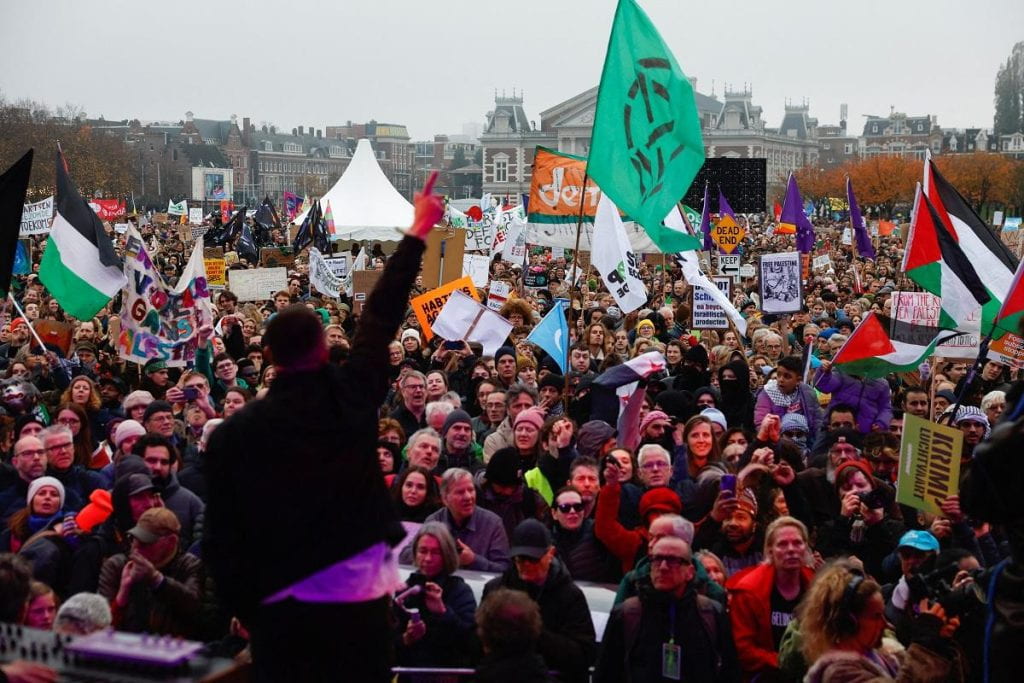
Palestinian flags during a climate protest last November 12 in Amsterdam. / Credit: Reuters
Victor van der Wurff sees the climate crisis as an intersectional one. “Everything is connected, we need to tackle all the facets of the underlying system.” When asked what precisely that system is, Victor deadpanned: “Capitalism.”
Through his work, he is also involved with the different communities that can be found in XR, such as XR Neurodiversity and XR Civil Servants. He also highlights the new group XR Rebels of Colour. The organisation has been criticised as a “White middle class movement” in the media. “XR Rebels of Color are trying to promote diversity within the organisation and, in principle, tell us how these things should be. They all say, ‘You should speak up about other things too, as it’s important, and then people of colour will also feel at home,” van der Wurff states.
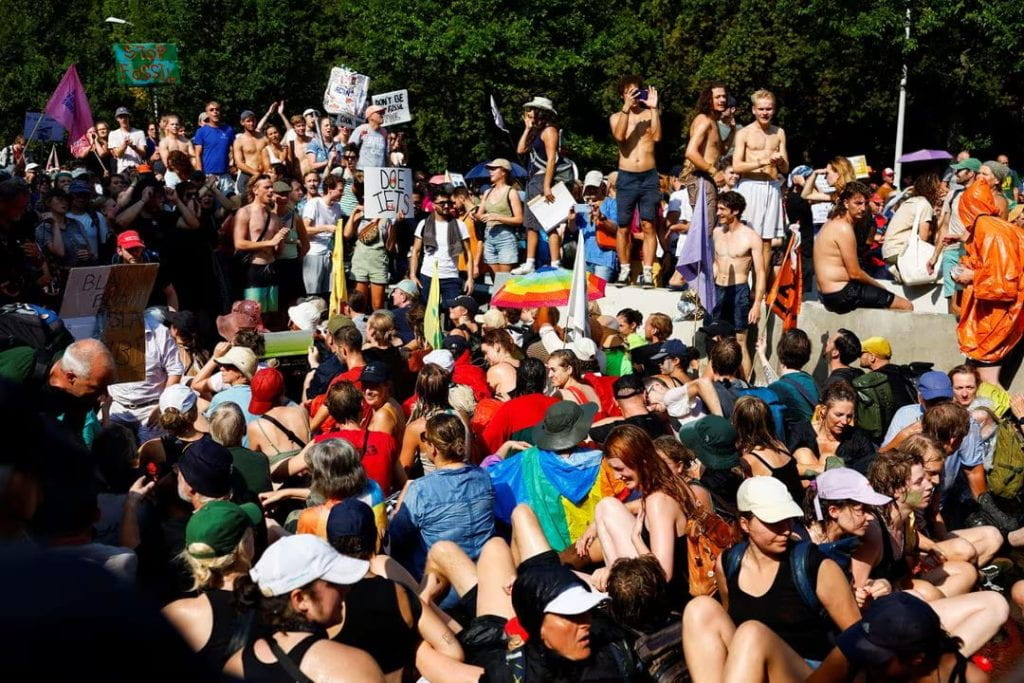
Climate activists block the A12 highway in The Hague last September. / Credit: Reuters
On the other hand, de Vries warns of blind fanaticism that comes with intersectionality, which according to him “almost resembles a religion.” “When you start bending over backwards to make everything fit within your ideology, something is wrong.” De Vries perceives the intersectional development as strategically unwise. “You are a climate movement and if you cannot explain to ‘Henk and Ingrid’ [ordinary names of Dutch people] in three sentences what a particular issue has to do with the climate, then it becomes very difficult to achieve XR’s goal of mobilising 3.5 percent of the population.”
Van der Wurff, however, considers such reasoning as a fallacy. As an example, he mentions the recent action called by XR-affiliated group Justice Now! who projected a Palestinian flag onto the Euromast, an iconic building in Rotterdam. “We immediately saw an influx of people of colour, especially those with an Arab background, who started looking more positively at XR and said, ‘Hey, I want to join’,” he explains. Yet, de Vries observes the opposite effect. In his view, many people do not dare to speak out about this issue and say that some have withdrawn their donations.
Mobilisation and social change
Extinction Rebellion has significant potential to achieve its mobilisation goal in the Netherlands, which it believes will lead to a substantial and effective overhaul of the status quo. In effect, survey research performed by ISSP shows that 64.6% of the Dutch population says to be concerned or very concerned about climate change.
Yet, most people abstain from participating in demonstrations: 93.1% have not taken part in any of them in the last five years. This is in line with Ipsos’s results, where 40% would want to do something, but do not know what.
The main challenge for XR in coming times will be getting people who are on the fence, off of it. According to sociologist van Stekelenburg activists tend to struggle with this dilemma.“ There is always a thin line between on one hand creating awareness and drawing attention, and on the other hand garnering sympathy and conveying sentiment,” she reflects.
Academic Research from neighbouring country Germany does give some perspective for a Dutch green course of action. António Valentim, a researcher at Yale University, has analysed the electoral impact of the climate movement of Fridays for Future in Germany. Valentim has found that repeated exposure to Friday for the Future protests was correlated with an increase of votes for the Green party with about 2 to 2.5 percent in recent years. When the study was replicated, the same results were found across six different European countries, including the Netherlands. However, Valentim warns that too much exposure may lead to voter fatigue.
The runner-up in the recent Dutch election, GroenLinks-PvdA (an alliance between the left green party GroenLinks with the Labour Party), finds themselves on the opposite side of the political spectrum from the far-right winner, with its main focus on climate. Despite the defeat, the left-wing party is looking at becoming the most influential opposition party.
After the election results, the environmental organisations are concerned with the current political situation in the country. Geert Wilder’s far-right party landslide victory in the recent parliamentary elections created a shockwave through XR. “It is terrible that a climate-denying party is now the biggest in the Netherlands,” says van der Wurff.
But he stresses that XR is “beyond politics”. On its official website, the organisation describes itself as a non-partisan movement seeking that citizens deliberate on various issues through high-quality information and deliver their recommendations to governments.
“We aim at ‘citizens’ assemblies’. We want to evolve into a deliberative democracy,” he states.
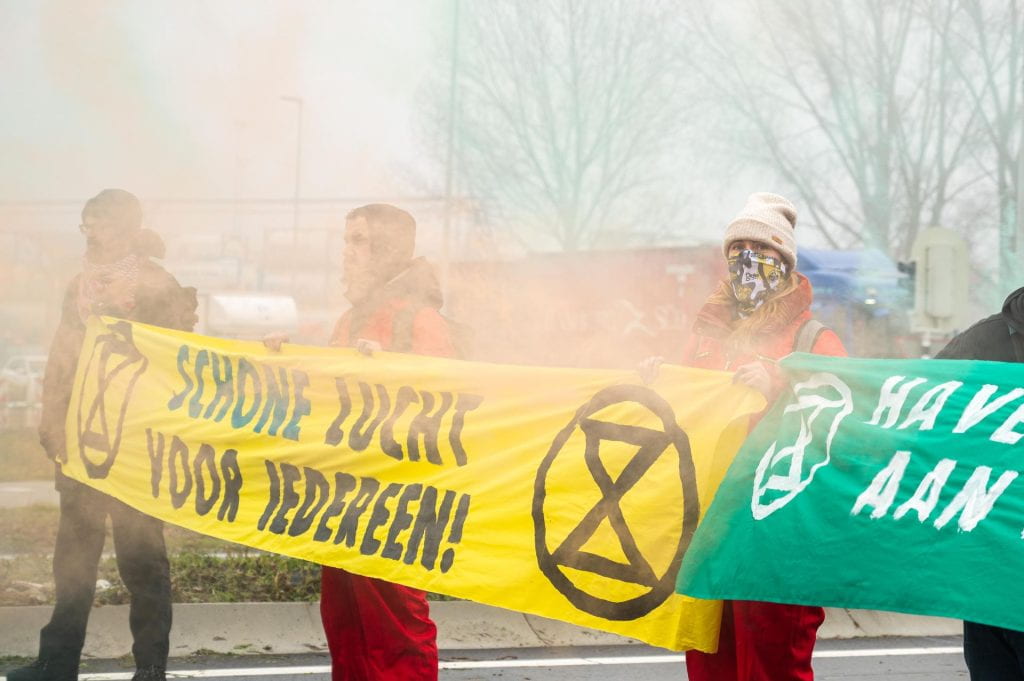
Protesters of the Dutch chapter of Extinction Rebellion. / Credit: Savannah van den Roovaart
The fight for a better environment is an uphill one, with some governments seemingly reluctant to take measures to stop emissions of carbon dioxide and other greenhouse gases in order to limit warming to 1.5C. The climate organisations know that they must maintain or increase their efforts to persuade governments to take action.
These organisations are made up of people like Victor van der Wurff who have made activism a priority in their lives with the consequently strain on their friendships and also passions such as drumming in a jazz band. And when asked if this is all worth it, Victor does not hesitate to answer: “Absolutely. The people around me are amazing, we do some incredible things together. It’s really great to be part of something that you can see grow so fast,” he reflects.
*This article is part of the series Environmental movements in Western Europe: the fight to avoid dangerous climate change.
Header Photo: Climate activists of the Dutch chapter of Extinction Rebellion blocking a road leading to the Rotterdam harbour. / Credit: Savannah van den Roovaart.